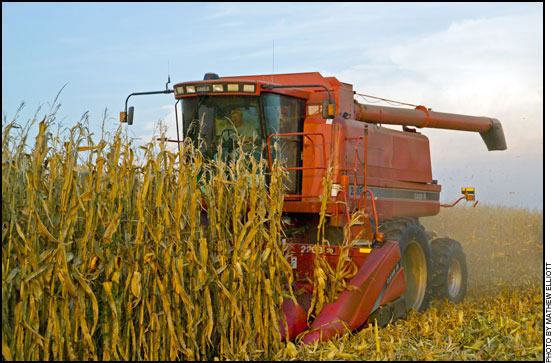

Darrell Mark
In the Cattle Markets
The corn supply continues to tighten.
The U.S. Department of Agricluture (USDA) published its January World Agricultural Supply and Demand Estimates (WASDE) Wednesday, Jan. 12, which provided a lot of bullish news for both the corn and soybean market.
Relative to the December estimate, USDA dropped the 2010-2011 corn yield by 1.5 bushel (bu.) per acre to 152.8 bu. per acre. The trade was generally expecting less than a half bu. per acre decrease in yield. This national yield results in a crop of 12.447 billion bu., 93 million bu. less than December's estimate and 44 million bu. less than the average pre-release estimates.
On the demand side of the balance sheet, USDA made no changes to total use, but did move 100 million bu. from feed and residual use to ethanol. This reflects the continuing trend of lower livestock inventories and good ethanol processing margins. Ending stocks for the 2010-2011 marketing year were projected at 745 million bu., a drop of 87 million bu. from the December estimate and 32 million bu. less than expected.
Probably the bigger surprise in the January WASDE report was on the soybean supply and demand table. The general trade sentiment heading into the report was for a steady to slightly higher yield estimate. Instead, USDA dropped the national soybean yield from 43.9 bu. per acre in the December report to 43.5 bu. per acre. Combined with a 200,000-acre drop in harvested acres, this resulted in production falling to 3.329 billion bu., about 47 million bu. less than expected.
USDA also lowered soybean total use by 16 million bu. (10 million for crushing and 6 million in the residual category). Thus, 2010-2011 soybean ending stocks, at 140 million bu., dropped 25 million bu. since the December report.
The numbers
in
this year's
report provide sufficient support
for continued
high prices.Reaction to the report was decidedly bullish Wednesday, Jan. 12, with corn prices closing about 24¢ per bu. higher and soybeans about 58¢ per bu. higher. Prices traded still higher on Thursday.
The January 2011 WASDE report was a sharp contrast to the January 2010 report that introduced six months of lower prices for the livestock industry to take advantage of last year. Instead, the numbers in this year's report provide sufficient support for continued high prices. While occasional retracements of price rallies are likely to occur, there will be continued volatility in the grain market and generally higher prices. Current futures prices, adjusted for Nebraska basis, suggest that cash corn prices will average very near $6 per bu. through 2011, compared to just under $4 per bu. realized in 2010.
Cattle feeders don't have very appealing alternatives for buying corn at this point. While many bought cash corn at harvest, those supplies will eventually run out later this spring. Ironically, much of this inventoried corn might run out about the time feeder cattle available for placement grow even tighter next summer. One alternative for some cattle feeders, particularly small or diversified operations, might be to significantly reduce the number of cattle they feed if they can't buy corn cheaper in the summer months. Otherwise, buying corn on breaks in the market might be the best they can do for the next several months.
The 745 million bu. carryout translates to a very tight 24-day excess supply of corn for this current marketing year (ending Aug. 31, 2010). Thus, the 2011 crop will be sensitive to acreage and yield risks because it doesn't have much cushion from a large carry-in supply.
 Opinions on whether the acreage battle for 2011 occurred last fall with fertilizer and seed sales or is still yet to come is quite mixed. I still favor the idea that the corn market will try to buy more acres than the approximately 90 million acres currently estimated, and that it will have a hard time doing so with high soybean, wheat, cotton and rice prices. Depending upon actual planted acreage, the 2011 corn crop could be ultrasensitive to yield risks and weather events in May, June and July.
Opinions on whether the acreage battle for 2011 occurred last fall with fertilizer and seed sales or is still yet to come is quite mixed. I still favor the idea that the corn market will try to buy more acres than the approximately 90 million acres currently estimated, and that it will have a hard time doing so with high soybean, wheat, cotton and rice prices. Depending upon actual planted acreage, the 2011 corn crop could be ultrasensitive to yield risks and weather events in May, June and July.
So, corn buyers have to be prepared for the possibility of additional corn price spikes, even if the 2011-2012 corn production turns out to be adequate.




